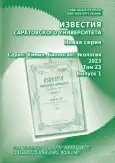4-Ethoxymethylene-2-phenyl-5(4H)-oxazolone in reactions with various heterocyclic amines
- Authors: Miroshnikova A.V.1, Tikhomolova A.S.1, Vasilkova N.O.1, Yegorova A.Y.1
-
Affiliations:
- Saratov State University
- Issue: Vol 23, No 1 (2023)
- Pages: 11-17
- Section: Articles
- URL: https://journal-vniispk.ru/1816-9775/article/view/251996
- DOI: https://doi.org/10.18500/1816-9775-2023-23-1-11-17
- EDN: https://elibrary.ru/YYULYI
- ID: 251996
Cite item
Full Text
Abstract
About the authors
Anna V. Miroshnikova
Saratov State University
ORCID iD: 0000-0002-5410-5401
83, Astrakhanskaya str., Saratov, 410012, Russia
Alexandra S. Tikhomolova
Saratov State University83, Astrakhanskaya str., Saratov, 410012, Russia
Natalia Olegovna Vasilkova
Saratov State University83, Astrakhanskaya str., Saratov, 410012, Russia
Alevtina Yu. Yegorova
Saratov State University83, Astrakhanskaya str., Saratov, 410012, Russia
References
- Zhang W., Liu W., Jiang X., Jiang F., Zhuang H., Fu L. Design, synthesis and antimicrobial activity of chiral 2-(substituted-hydroxyl)-3-(benzo[d]oxazol-5-yl) propanoic acid derivatives // Eur. J. Med. Chem. 2011. Vol. 46, № 9. P. 3639–3650. https://doi.org/10.1016/j.ejmech.2011.05.028
- Kumar D., Kumar N. M., Sundaree S., Johnson E. O., Shah K. An expeditious synthesis and anticancer activity of novel 4-(3´-indolyl)oxazole // Eur. J. Med. Chem. 2010. Vol. 45, № 3. P. 1244–1249. https://doi.org/10.1016/j.ejmech.2009.12.024
- Moraski G. C., Chang M., Villegas-Estrada A., Franzblau S. G., Möllmann M., Miller M. J. Structure-activity relationship of new anti-tuberculosis agents derived from oxazoline and oxazole benzyl esters // Eur. J. Med. Chem. 2010. Vol. 45, № 5. P. 1703–1716. https://doi.org/10.1016/j.ejmech.2009.12.074
- Eren G., Ünlü S., Nuñezv M. T., Labeaga L., Ledo F., Entrena A., Ea Banoğlu, Costantino G., Şahin M. F. Synthesis, biological evaluation, and docking studies of novel heterocyclic diaryl compounds as selective COX-2 inhibitors // Bioorg. Med. Chem. 2010. Vol. 18. P. 6367–6376. https://doi.org/10.1016/j.bmc.2010.07.009
- Ashton W. T., Sisco R. M., Dong H., Lyons K. A., He H., Doss G. A., Leiting B., Patel R. A., Wu J. K., Marsilio F., Thornberry N. A., Weber A. E. Dipept idyl peptidase IV inhibitors derived from β-aminoacylpiperidines bearing a fused thiazole, oxazole, isoxazole, or pyrazole // Bioorg. Med. Chem. Lett. 2005. Vol. 15, № 9. P. 2253–2258. https://doi.org/10.1016/j.bmcl.2005.03.012
- Jadhav R. D., Kadam K. S., Kandre S., Guha T., Reddy M. K., Brahma M. K., Deshmukh N. J., Dixit A., Doshi L., Potdar N., Enose A. A., Vishwakarma R. A., Sivaramakrishnan H., Srinivasan S., Nemmani V. S., Gupte A., Gangopadhyay A. K., Sharma R. Synthesis and biological evaluation of isoxazole, oxazole, and oxadiazole containing heteroaryl analogs of biarylureas as DGAT1 inhibitors // Eur. J. Med. Chem. 2012. № 54, P. 324–342. https://doi.org/10.1016/j.ejmech.2012.05.016
- Parveen M., Ali A., Ahmed S., Malla A. M., Alam M., Silva P. S. P., Silva M. R., Lee D. U. Synthesis, bioassay, crystal structure and ab initio studies of Erlenmeyer azlactones // Spectrochim. Acta. A Mol. Biomol. Spectrosc. 2013. № 104. P. 538–545. https://doi.org/10.1016/j.saa.2012.11.054
- Benoiton N. L., Hudecz F., Chen F. F., and M. F. Amino-acid conjugates of the hapten 2-phenyl-4-ethoxymethylene-5(4H)-oxazolone. Synthesis and confi rmation of structure // Intern. J. Peptide Protein Res. 1995. Vol. 45. P. 266–271.
- Osipov A. K., Anis’kov A. A., Grinev V. S., Yegorova A. Y. Study of E/Z isomerization of (arylamino)methylidenefuran-2(3H)-ones by 1H, 13C, 15N spectroscopy and DFT calculations in different solvents // Magnetic Resonance in Chemistry. 2017. Vol. 55, № 8. P. 730–737. https://doi.org/10.1002/mrc.4583
- Osipov A. K., Anis’kov A. A., Yegorova A. Y. Synthesis and confi guration of (arylamino)methylidene-3Hfuran-2-ones // Russian Journal of Organic Chemistry. 2017. Vol. 53, iss 2. P. 210–214. https://doi.org/10.1134/s1070428017020117
- Тихомолова А. С., Майорова О. А., Егорова А. Ю. Cинтез и особенности строения 5-(4-бромфенил)- 3-((6-амино-2-меркаптопиримидин)-4-амино)) метилиден)-3Н-фуран-2-она // Известия Саратовского университета. Новая серия. Серия: Химия. Биология. Экология. 2022. Т. 22, вып. 1. С. 4–8. https://doi.org/10.18500/1816-9775-2022-22-1-4-8
- Shuvalov V. Yu., Rozhkova Yu. S., Plekhanova I. V., Kostyuchenko A. S., Shklyaev Yu. V., Fisyuk A. S. Synthesis of 3-amino-6,7-dihydroferroceno[a]quinolizin-4-one derivatives by the reaction of 3,4-dihydroferroceno[c] pyridines with azlactones // Chem. Heterocycl. Compd. 2022. Vol. 58, iss. 1. P. 7–14. https://doi.org/10.1007/s10593-022-03050-5
Supplementary files









